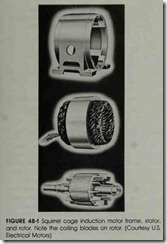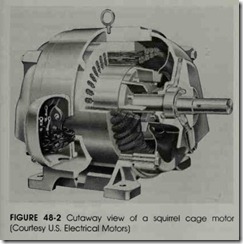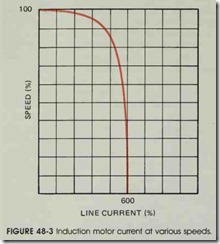Objectives
After studying this unit, the student will be able to:
• Describe the most important factors to consider when selecting motor starting equipment
• State why reduced current starting is important
• Describe typical starting methods
• Identify squirrel cage induction motors
• Describe how a squirrel cage motor functions
There are two reasons for the use of reduced voltage starting:
1. To reduce the high starting current drawn by the motor.
2. To reduce the starting torque provided by the motor.
The simplicity, ruggedness, and reliability of squirrel cage induction motors have made them the standard choice for alternating-current, all purpose, constant speed motor applications. Sev eral types of motors are available; therefore, var ious kinds of starting methods and control equip ment are also obtainable.
THE MOTOR
The Revolving Field
The squirrel cage motor consists of a frame, a stator, and a rotor. The stator, or stationary portion carries the stator windings, figure 48-1 (cen ter). The rotor is a rotating member, figure 48-1 (bottom) which is constructed of steel laminations mounted rigidly on the motor shaft. The rotor winding consists of many copper, or aluminum, bars fitted into slots in the rotor. The bars are con nected at each end by a closed continuous ring. The assembly of the rotor bars and end rings re sembles a squirrel cage. This similarity gives the motor its name, squirrel cage motor.
For a three-phase motor, the stator frame has three windings. The stator for a squirrel cage mo tor never has fewer than two poles. The stator windings are connected to the power source. When a 60-hertz current flows in the stator wind ing, a magnetic field is produced. Because of the three-phase alternating current and the displace ment of each phase winding, this field circles the rotor at a speed equal to the number of revolutions per minute (r/min or rpm) divided by the number of pairs of stator poles. Therefore, on 60 hertz, a motor having one pair of two poles will run at 3600 r/min; a four-pole motor (two pairs of two poles each) will run at 1800 r/min (3600/2). The revolving stator magnetic field induces current in the short-circuited rotor bars. The induced cur rent in the squirrel cage then has a magnetic field of its own. The two fields interact, with the rotor field following the stator rotating field, thereby es tablishing a torque on the motor shaft. The cur rent induced has its largest value when the rotor is at a standstill. The current then decreases as the motor comes up to speed. In designing motors for specific applications, changing the resistance and reactance of the rotor will alter the characteristics of the motor. For any one rotor design, however, the characteristics are fixed. There are no external connections to the rotor. A cutaway view of an as sembled squirrel cage motor is shown in figure 48-2.
Locked Rotor Currents
The locked rotor current and the resulting torque are factors which determine if the motor can be connected across the line or if the current must be reduced to obtain the required perfor mance. Locked rotor currents for different motor types vary from 2 112 to 10 times the full-load cur rent of the motor. Some motors, however, have even higher inrush currents.
The Induction Motor At Start
Figure 48-3 illustrates the behavior of the current taken by an induction motor at various speeds. First, note that the starting current is high compared to the running current. In addition, the starting current remains fairly constant at this high value as the motor speed increases. The cur rent then drops sharply as the motor approaches its full rated speed. Since the motor heating rate is a function of I2R (copper loss), this rate is high during acceleration. For most of the acceleration period, the motor can be considered to be in the locked condition.
No-Load Rotor Speed
The induced current in the rotor gives rise to magnetic forces which cause the rotor to turn in the direction of rotation of the stator field. The motor accelerates until the necessary speed is reached to overcome windage and friction losses. This speed is referred to as the no-load ·speed. The motor never reaches synchronous speed since a current will not be induced in the rotor under these conditions and thus the motor will not pro duce a torque. Torque refers to the twisting or turning of the motor shaft. (The rotor bars of the squirrel cage must be cut by the rotating magnetic ac field to produce a torque.)
Speed Under Load
As the rotor slows down under load, the speed adjusts itself to the point where the forces exerted by the magnetic field on the rotor are suf ficient to overcome the torque required by the load. Slip is the term given to the difference be tween the speed of the magnetic field and the speed of the rotor.
The slip necessary to carry the full load de pends on the characteristics of the motor. In gen eral, the following situations are true:
1. The higher the inrush current, the lower the slip at which the motor can carry full load, and the higher the efficiency.
1. The lower the value of inrush current, the higher the slip at which the motor can carry full load, and the lower the efficiency.
An increase in line voltage causes a decrease in the slip, and a decrease in line voltage causes an increase in the slip. In either case, sufficient cur rent is induced in the rotor to carry the load. A decrease in the line voltage causes an increase in the heating of the motor. An increase in the line voltage decreases the heating. In other words, the motor can carry a larger load. The slip at rated load may vary from 3 percent to 20 percent for different types of motors.
Variation of Torque Requirements
Different loads have different torque require ments. This must be kept in mind when consid ering the starting torque required and the rate of acceleration most desirable for the load. In gen eral, a number of motors will satisfy the load re quirements of an installation under normal run ning conditions. However, it may be more difficult to use a motor that will perform satisfac torily during both starting and running. Often, it is necessary to decide which is the more important factor to consider for a particular application. For example, a motor may be selected to give the ?est starting performance, but there may be a sacrifice in the running efficiency. In another case, to ob tain a high running efficiency, it may be necessary to use a motor with a high current inrush. For these and other examples, the selection of the proper starter to overcome the objectionable fea tures is an important consideration in view of the high cost of energy today.
The machine to which the motor is connected may be started at no load, normal load, or over load conditions. Many industrial applications re quire that the machine be started when it is not loaded. Thus, the only torque required is that nec essary to overcome the inertia of the machine. Other applications may require that the motor be started while the machine it is driving is subjected to the same load it handles during normal run ning. In this instance, the starting requirements include the ability to overcome both the normal load and the starting inertia.
Important factors in providing the proper starting equipment include using a starter that sat isfies the horsepower rating of the motor, and con necting the motor directly across the line. Another factor is that the motor itself must meet the torque requirements of the industrial application. Ac tually, the starting equipment may be selected to provide adequate control of the torque after the motor is selected.
Controlling Torque
The most common method of starting a poly phase, squirrel cage induction motor is to connect the motor directly to the plant distribution system at full voltage. In this case a manual or a magnetic starter is used. From the standpoint of the motor itself, this is a perfectly acceptable practice. As a matter of fact, it is probably the most desirable method of starting this type of motor.
Overload protective devices have reached such a degree of reliability that the motor is given every opportunity to make a safe start. The appli cation of a reduced voltage to a motor in an at tempt to prevent overheating during acceleration is generally wasted effort. The accelerating time will increase and correctly sized overload elements may still trip.
Reduced voltage starting minimizes the shock on the driven machine by reducing the starting torque of the motor. A high torque, applied sud denly, with full voltage starting, may cause belts to slip and wear or may damage gears, chains, or couplings. The material being processed, or con veyed, may be damaged by the suddenly applied jerk of high torque. By reducing the starting volt age, or current, at the motor terminals, the start ing torque is decreased.
Reduced Voltage, Reduced Current, Reduced Torque
The category of reduced voltage methods generally includes all starting methods which de viate from standard, line voltage starting. Not all of these starting schemes reduce the voltage at the motor terminals. Even reduced voltage starters re duce the voltage only to achieve either the reduction of line current or the reduction of starting torque. The reduction of line current is the most commonly desired result.
You should note one important point: When
the voltage is reduced to start a motor, the current is also reduced, and so is the torque that the machine can deliver. Regardless of the desired result (either reduced current or reduced torque), remember that the other will always follow.
If this fact is kept in mind, it is apparent that a motor which will not start a load on full voltage cannot start that same load at reduced voltage or reduced current conditions. Any attempt to use a reduced voltage or current scheme will not be suc cessful in accelerating troublesome loads. The very process of reducing the voltage and current will further reduce the available starting torque.
Need for Reduced Current Starting
The most common function of reduced volt age starting devices is to reduce, or in some way modify, the starting current of an induction mo tor. In other words, the rate of change of the starting current is confined to prescribed limits, or there is a predetermined current-time picture that the motor presents to the supply wiring network.
A current-time picture for an entire area is maintained and regulated by the public power utility serving the area. The power company at tempts to maintain a reasonably constant voltage at the points of supply so that lamp flicker will not be noticeable. The success of the power company in this attempt depends on the generating capacity to the area; transformer and line loading condi tions and adequacies; and the automatic voltage regulating equipment in use. Voltage regulation also depends on the sudden demands imposed on the supply facilities by residential, commercial, and industrial customers. Transient overloading of the power supply may be caused by: (1) sudden high surges of reactive current from large motors on starting, (2) pulsations in current taken by elec trical machinery driving reciprocating compressors and similar machinery, (3) the impulse demands of industrial x-ray equipment, and (4) the variable power factor of electric furnaces. All of these demands are capable of producing voltage fluctua tions.
Therefore, each of these particularly difficult loads is regulated in some way by the power util ity. The utility requires the use of some form of reduced voltage, reduced current method and helps its customers determine the best method.
Power company rules and regulations vary between individual companies and the areas served. The following list gives some commonly applied regulations. (All of the possible restric tions on energy usage are not given.) An installa tion may be governed by just one of these restric tions, or two or more rules may be combined. Regulations include:
1. A maximum number of starting amperes, ei ther per horsepower or per motor.
2. A maximum horsepower for line starting. A limit in percent of full load current is set for anything above this value.
3. A maximum current in amperes for a partic ular feeder size. It is up to the user to deter mine if the motor will conform to the power company requirements.
4. A maximum rate of change of line current taken by the motor; for example, 200 am peres per half-second.
It should be apparent that it is very important for the electrician to understand the behavior of an induction motor during the startup and accel eration periods. Such an understanding enables you to select the proper starting method to con form to local power company regulations. Al though several starting methods may appear to be appropriate, a careful examination of the specific application will usually indicate the one best method for motor starting.
TYPICAL STARTING METHODS
The most common methods of starting poly phase squirrel cage motors include:
• Full voltage starting: a hand-operated or auto matic starting switch throws the motor di rectly across the line.
• Primary resistance starting: a resistance unit connected in series with the stator reduces the starting current.
• Autotransformer or compensator starting: manual or automatic switching between the taps of the autotransformer gives reduced voltage starting.
• Impedance starting: reactors are used in series with the motor.
• Star-delta starting: the stator of the motor is star connected for starting and delta con nected for running.
• Part winding starting: the stator windings of the motor are made up of two or more cir cuits; the individual circuits are connected to the line in series for starting and in parallel for normal operation.
Of these methods, the two most fundamental ways of starting squirrel cage motors are full volt age starting and reduced voltage starting. Once again, full voltage starting can be used where the driven load can stand the shock of starting and objectionable line disturbances are not created. Reduced voltage starting may be required if the starting torque must be applied gradually or if the starting current produces objectionable line distur bances.
REVIEW QUESTIONS
1. List five commonly used starting methods.
2. When can full voltage starting be used?
3. Name the simplest, most rugged and reliable ac motor. Describe how it operates.
4. Describe the term, slip.
5. When the voltage is reduced to start a motor, what happens to the
a. torque?
b. current?
6. Why is it more advisable to start some machines at reduced torque?








